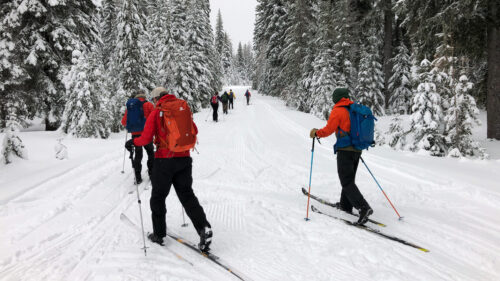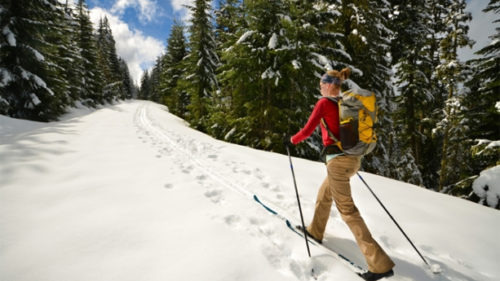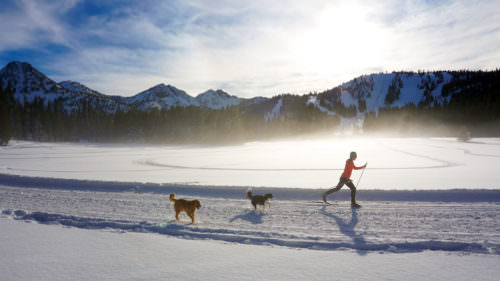Cross-country skiing is half cardio workout, half mind-body enlightenment experience. It’s “listening to the snow and trees, breathing the fresh air, and generally being at one with nature in a rare winter way,” describes Bend athlete Julie Southwell. It’s “staying perfectly warm while moving smoothly on the frozen land.”
And it’s an experience Southwell wants to share with beginners. She has competed nationally in cross-country skiing and taught the sport for more than two decades, including the past 11 years at Mt. Bachelor Nordic Center.
It’s the peaceful and quiet reflective time in snowy natural landscapes that has continually captivated her attention. “I also find that my many years of teaching yoga and music give me extra skills to offer and inspire ski students in body awareness, breathing, alignment and rhythm,” she says.
Cross-country skiing is simply a great way to get outdoors and appreciate Oregon’s wintertime beauty, adds Kelly Crowther, a lifetime Sisters resident who has also competed nationally. Crowther has shared his love of the sport as a coach for high-desert programs like Bend Endurance Academy and the Sisters High School ski team. “Some of the beautiful experiences in nature that have profoundly stuck with me while cross-country skiing are seeing alpenglow sunsets on the Cascades, skiing by moonlight back to the car and summiting Hoodoo on Nordic skis,” he says.
Unlike downhill or alpine skiing, cross-country skiing allows you to go at your own pace since gravity isn’t pulling you — you’re in control of your own momentum. Whether you go fast or slow, it can bring heaps of relaxing winter chill.
It can demand a good amount of endurance and perhaps a lesson or two on practical technique, but learning the ropes and acquiring gear is accessible for beginners and families if you know where to start. Here are some tips from a couple of high-desert experts so you, too, can get started exploring the majestic snowscapes of Central Oregon.
Where to Go for Your Cross-Country Ski Adventure
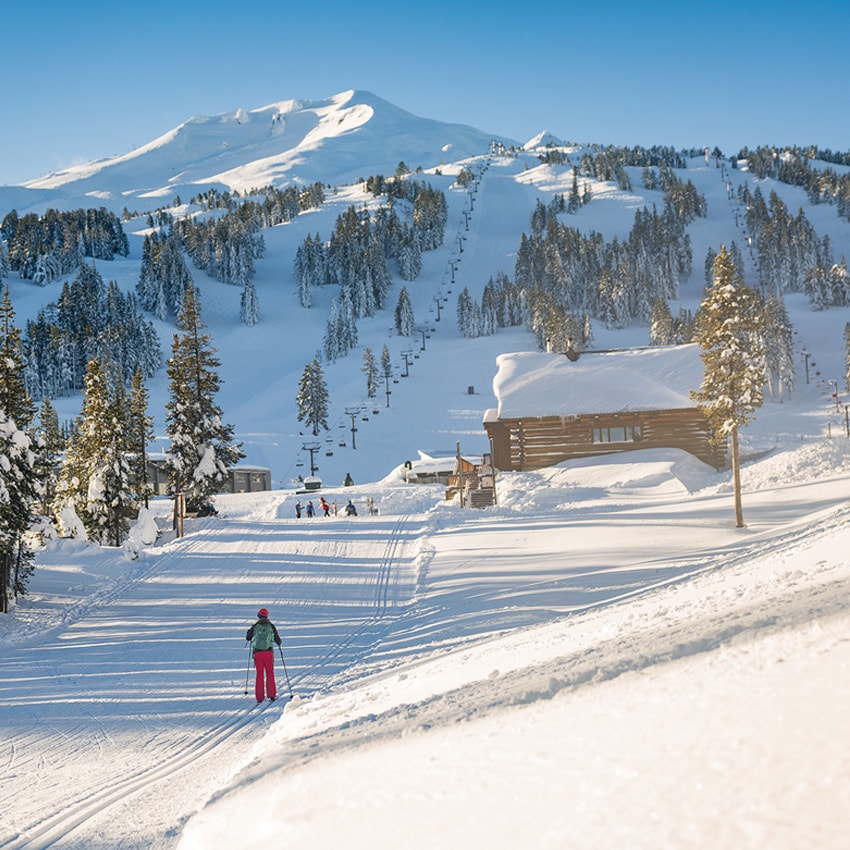
True Beginners
On-Site Rentals and Apres-Ski Dining
Some of the benefits of visiting a resort to cross-country ski are on-site rentals, opportunities for lessons, retail shops for last-minute purchases, and apres-ski dining options. For a beginner ski experience at Mt. Bachelor Nordic Center, Southwell highly recommends the oval and green loop trails. If you aren’t ready to go it alone, on the roads or trails, take the Mt. Bachelor Shuttle to the Nordic lodge and sign up for a lesson with an expert instructor.
At Hoodoo Ski Area Nordic, just north of Sisters and off of Santiam Pass, Crowther says beginners will like the friendly, gentle terrain and exceptionally groomed trails (those with hard-packed snow that’s easier to glide across, with parallel ski tracks already set in place). You can set each ski in the side-by-side tracks for the duration of your outing for great success.
At both Mt. Bachelor and Hoodoo, midweek and non holiday timing is ideal for avoiding crowds. Evening and early-morning outings are also a lot of fun, and generally less crowded.
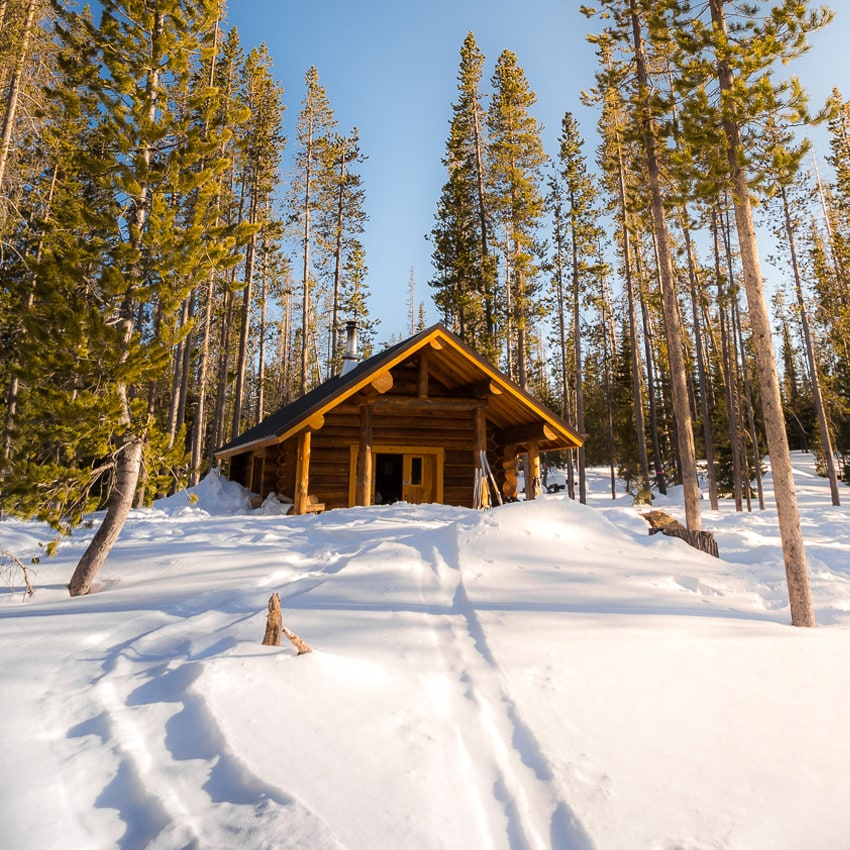
Still a Beginner
Groomed Trails and Warming Huts
Central Oregon is home to a number of amazing sno-parks, most of which are very popular, so it’s important to know what to expect at Oregon’s sno-parks during COVID-19. Meissner Nordic is located in Meissner Sno-Park, on the way to Mt. Bachelor Ski & Snowboard Resort. It was developed by neighborhood pro cross-country skiers in the 1990s, inspired by the club-skiing atmosphere like those in Europe. Today Meissner Nordic offers trails groomed and ungroomed (with pristine, untouched snow) all funded through community donations. Here you’ll also find marked ungroomed trails for snowshoeing, and three warming huts (Nordeen, Shooting Star and Virginia Meissner) that are great for a hot-beverage break out of the elements.
Crowther recommends checking the grooming schedule; he says newly groomed trails are ideal for beginners because these grooves in the snow cradle your skis, preventing them from crossing. (Ungroomed trails are challenging for beginners because the uneven terrain allows skis to more easily cross, causing you to fall.) The Meissner trail network and amenities can also be accessed via Swampy Lakes Sno-Park, a bit farther east. This is a nice option if parking at Meissner fills up.
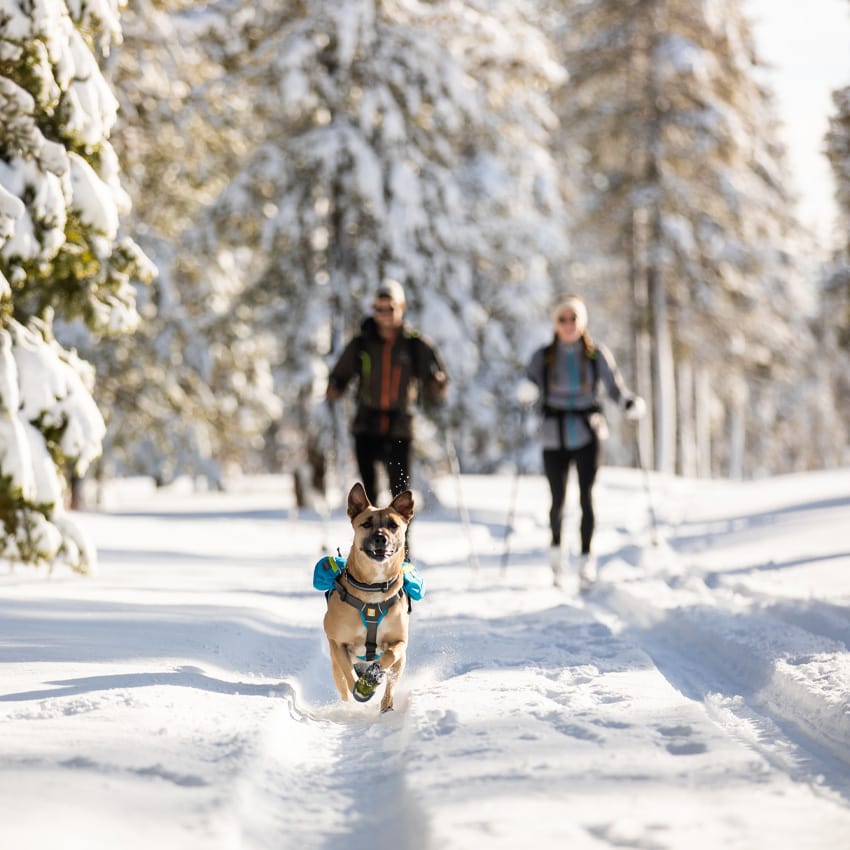
Intermediate Level and Beyond
Pet-Friendly, Ungroomed Trails
Just past the entrance of Meissner Sno-Park, find a groomed, dog-friendly cross-country ski track (just over 2 miles long) at Wanoga Sno-Park. It’s maintained by DogPAC, a local nonprofit that supports off-leash recreation opportunities in Central Oregon. Please be mindful of separate trails designated for snowshoeing. Find more dog-friendly, ungroomed trails at Skyliners, Edison Butte and Kapka sno-parks. You may even see some skijoring, in which a dog tows the cross-country skier.
Ungroomed trails can be hard work depending on how much snow has fallen, since they can get more icy in cold and wet conditions than groomed trails. Consider leaving these trails for intermediate cross-country skiers until you have some experience under your belt.
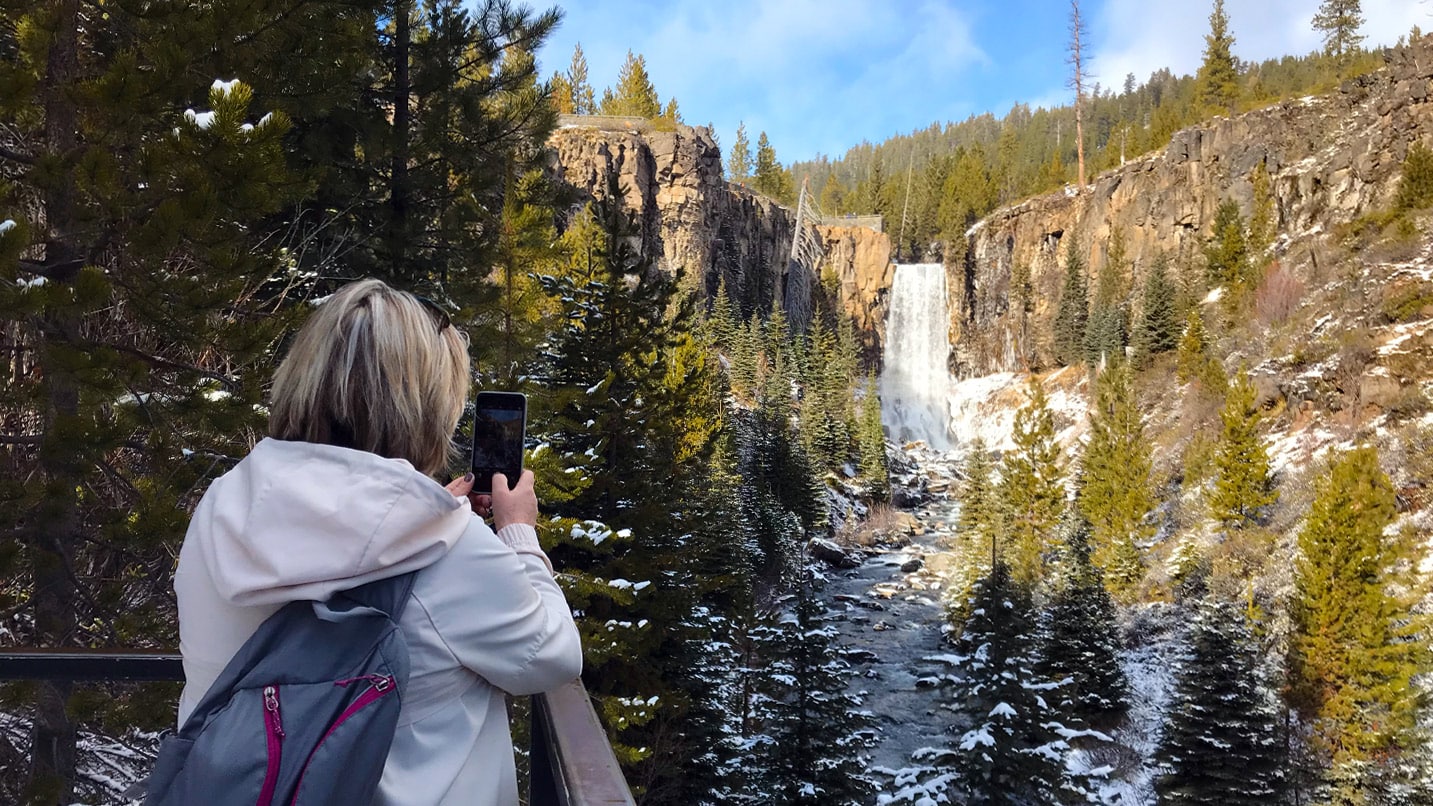
Pointers for Your First Outing
After you’ve picked a wintry trail to try, there are a couple of tricks that can help you start gliding across the snow in no time. Crowther suggests first trying to balance on one ski. Try transferring your weight from leg to leg, ski to ski, one side at a time. Put your full weight on one side while pausing in balance. This will help you balance on skis one at a time. Practice balancing with some family games: “Try playing soccer with one ski on, have relay races with one ski on and have a contest to see how far you can glide downhill on one ski,” Crowther says.
Another tip from Southwell: At some point on your first adventure, try to cross-country ski without your poles just to get a feel for the balance required. This will help you learn to balance independently of the poles. Leaning too much weight on your poles is a common beginner mistake.
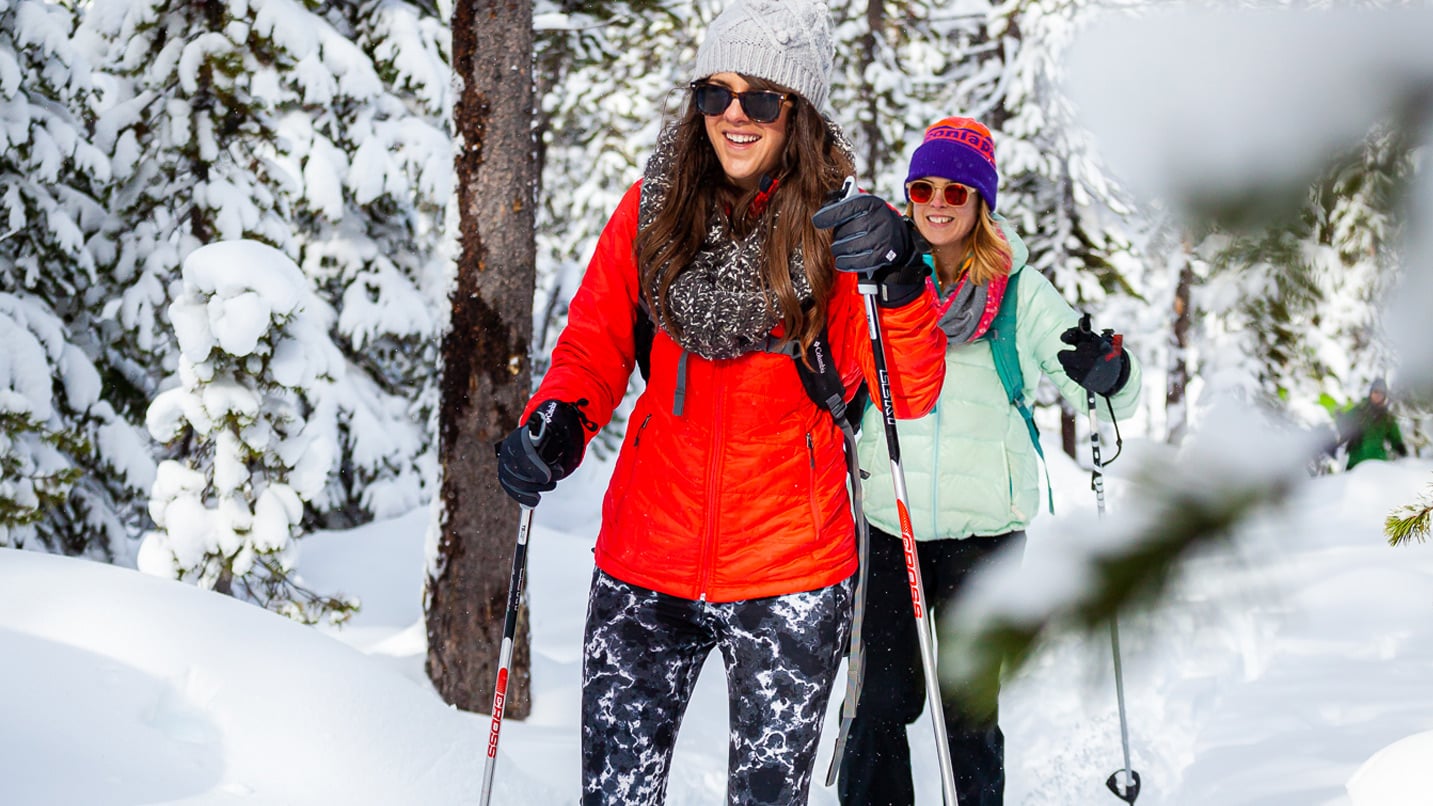
Gearing Up for Your Cross-Country Ski Trip
How to Dress
Pro tip No. 1: Don’t wear the same jacket and snow pants that you’d wear for downhill skiing. This is a cardio workout, so it’s best to dress in several lighter layers — preferably breathable fabrics. “Layers allow adjustments for weather changes and exercise levels,” Southwell says. When you stop for lunch or a snack, you’ll get cold very quickly, so pack an extra-warm jacket to help warm up again.
For base layers, Crowther suggests wool layers if it’s cooler than 25 degrees, and synthetic fabrics otherwise. For outer layers, water-resistant pants and jackets are ideal. That long-forgotten windbreaker stashed in the back of your closet could do the trick.
Another tip that will save you a lot of hassle is to leave the ski goggles at home since this is a cardio workout, a bit different from downhill skiing. When you start breathing heavily and breaking a sweat, the goggles will fog up and become uncomfortable. Try clear or yellow lenses on low-light days and sunglasses on bluebird days — and there are lots of those in Central Oregon.
What to Bring
One of the biggest concerns of beginners is often how to carry their gear while cross-country skiing. Bring a small backpack or large waist pack to carry layering choices and accessories you may shed like gloves, hats, warm socks and sunglasses. You’ll also want to keep water, snacks, a trail map and a cellphone handy. Since cross-country skiing is a cardio sport, Crowther suggests bringing a dry shirt for afterward so you can change out of the cold, wet, sweaty one. And whatever you do, don’t stop drinking fluids. Even though it’s winter, the sun often shines bright and can dehydrate cross-country skiers.
Where to Find Gear
Locals in Central Oregon know the best place to rent equipment is Powder House in Bend, which offers daily and seasonal ski rentals as well as the latest and greatest in newly released ski gear. If you’re on a budget, you might want to check out the mostly like-new, secondhand offerings at Gear Fix in Bend. Not only can you find a great deal on previously owned boots and skis, you can find backpacks, waist packs, winter hats, gloves, water bottles, local maps and more. Both shops offer state-of-the-art, next-day tuning and waxing.
If You Go:
Wherever you head out, remember to Take Care Out There when adventuring on Oregon’s winter trails. Check road and weather conditions before you go; bring your Ten Essentials plus more for snowy conditions, such as tire chains; and make an informed plan — such as heading to Plan B if Plan A is too crowded, or if the conditions are poor. Always be welcoming and respectful to all user groups, and leave the trails cleaner than you found them.
